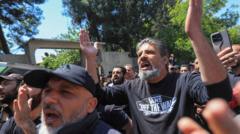In the Damascus suburb of Ashrafiyat Sahnaya, gunfire forced Lama al-Hassanieh to hide in her bathroom, raising fears for her safety as fighters wearing military attire prowled the streets. Shouts of "Jihad against Druze" echoed outside, leaving her unable to identify the attackers—were they extremists, government forces, or something else? The Druze community, a distinctive religious group originating from an offshoot of Shia Islam, has historically navigated a precarious political landscape in Syria. Under the regime of Bashar al-Assad, many Druze felt a sense of loyalty to the state, believing it would shield them from the sectarian violence wreaking havoc in other regions.
Initially, during the civil war's early years, many Druze remained outwardly supportive of the regime in hopes of protection. Assad aimed to cast himself as a defender of minorities, refraining from using harsh measures against Druze protesters while cracking down on dissent in other areas. The Druze maintained their militias to safeguard their communities from Sunni extremist attacks, but their security assurances have unraveled since Sunni Islamist rebel factions began to gain power.
Tensions escalated when a false audio recording of a Druze cleric allegedly insulting the Prophet Muhammad emerged, spurring sectarian violence and public calls for retaliation against the Druze community from some Muslim youth. The Syrian Observatory for Human Rights reported a death toll exceeding 137 in recent clashes in Ashrafiyat Sahnaya and other regions, prompting fears that the state, which claims to protect all citizens, is failing in its duty.
In a climate of rising aggression, some young Druze, such as pharmacy student Lama Zahereddine, recount horrific experiences of direct assaults and intimidation, including physical violence targeting students on campus. Disillusionment grows as classmates mock the plight of Druze individuals, further undermining trust in their surroundings.
Volunteers from the Druze community attempted to defend themselves, suffering losses as they faced armed groups during their protective efforts. Hadi Abou Hassoun, who was ambushed while aiding his community, voiced a collective yearning for legal protections over sectarian ideologies that threaten their existence.
While clashes have subsided, trust in the government's commitment to ensuring safety for minorities remains tenuous. The Syrian leadership publicly reaffirms its dedication to the sovereignty and unity of the nation; however, recent violence raises concerns about its effectiveness. As Israel engages in strikes aimed at protecting Druze communities from external threats, the internal struggle for respect and safety continues.
Back home in Ashrafiyat Sahnaya, Lama al-Hassanieh observes a more tranquil environment, yet wariness prevails. The lingering anxiety and uncertainty about neighbors' allegiances sow division in a community longing for justice and equal rights—Nurturing an atmosphere where they feel accepted as full citizens of Syria rather than minimized as a minority group.



















